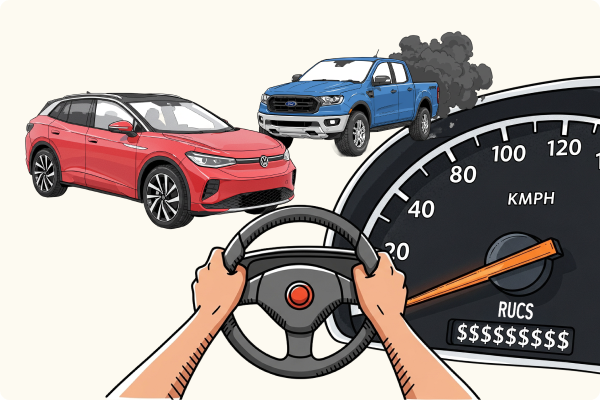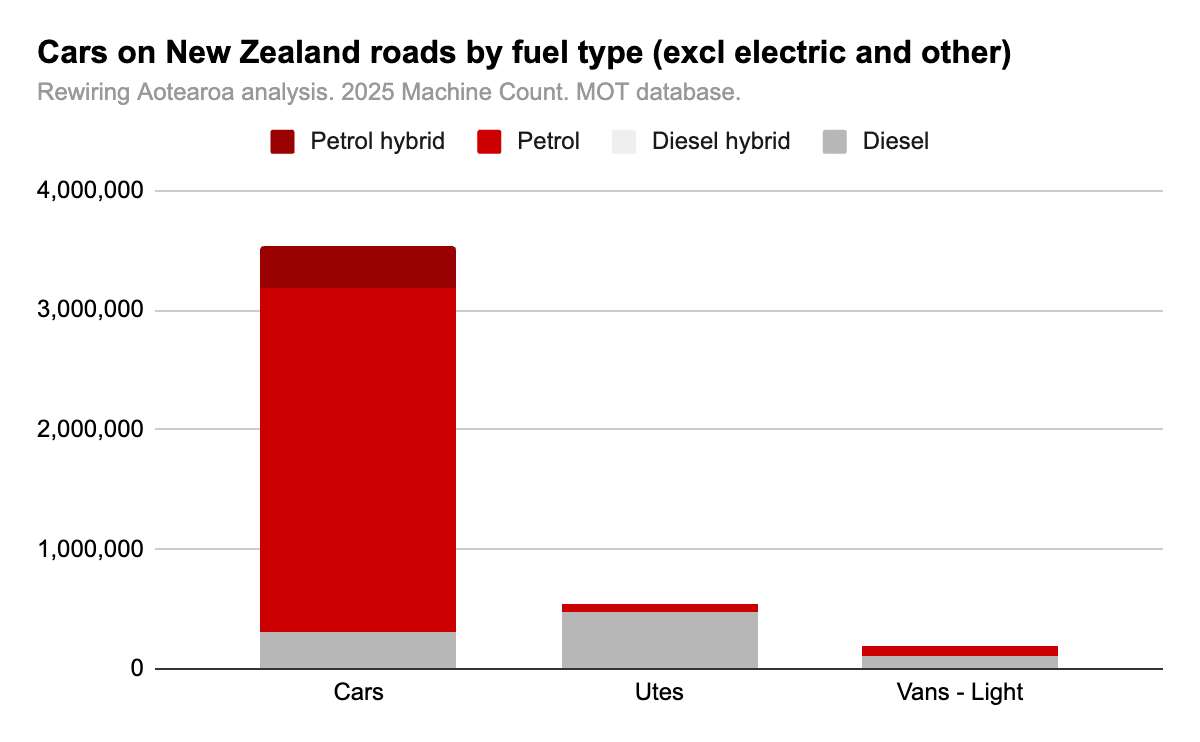Up the Kilowahs! Checkout the EDB Scoreboard



Analysis by Rewiring Aotearoa shows that all light vehicles being subject to Road User Charges will help level the playing field for electric vehicles and stop an unfair tax advantage for petrol cars.
“A lot of people have asked us what we think about this change so we’ve spent some time looking at the numbers,” says Rewiring Aotearoa CEO Mike Casey. “We believe it will drive faster EV uptake because under the new RUCs system EVs will be the cheapest per kilometre travelled and increased EV uptake will lead to faster emissions reductions.”
Casey says people should pay for the impact they have, so a large, heavy 4x4 should pay more for its impact on roads than a small hatchback, as should large trucks pay more than cars.
“There are also plenty of external impacts on society from the emissions created by vehicles that should be economically accounted for, too.”
Rewiring Aotearoa’s policy manifesto rated moving all vehicles to RUCs as a 4/10 in terms of impact and its analysis suggests that this change will lead to an increase in the cost to run most petrol vehicles and a bigger increase in the cost to run hybrids.
.png)
Based on someone driving an average distance of 11,000km per year, the cost to run a Ford Ranger diesel would remain at the same level (around $2,800), while the cost to run a Toyota RAV4 hybrid will increase by about $302 per year to around $2,100, and a Toyota Aqua Hybrid would increase by $419 to around $1,800.*
The cost to run a seven-seater Kia EV9 AWD electric vehicle remains the same at about $1,600 per year, and the cost to run a Tesla Model Y AWD about $1,400 per year. Both save around $1000 per year compared to equivalent petrol vehicles.
“Even with higher upfront costs, electric vehicles are still lower cost over their lifetime, primarily due to the savings on fuel,” says Casey.
Some very high-consuming cars, like a Ford Mustang V8 or a very large petrol ute, would get a slightly lower yearly bill.
“But most cars are not Mustangs, most utes are not petrol, and burning the amount of fuel a V8 does comes with its own economic signal because it’s so expensive to run,” says Casey.
There are nearly 500,000 diesel utes in the country that are already paying RUCs and this will not change under the new scheme. There are about 65,000 petrol utes in New Zealand and the tax paid by them may not change much, if they are already paying close to the same amount of road tax as diesel utes.
However, there are 2.9 million petrol vehicles, almost all of which will now pay more in total, and another 350,000 or so petrol hybrid vehicles, which will also pay more.
“For around 65,000 cars this may not change much, but for over three million cars, this will further encourage them to realise the underlying economics and switch to electric. It’s important to remember that no fossil fuel car is efficient when you compare it to an electric one.”

Also, most electric vehicle alternatives are available for SUVs and small cars.
“That’s where the technology exists to go fastest on electrification. The upfront cost of EVs also continues to fall, so we’re getting closer to price parity and the secondhand EV market is also growing. You can get a cheap Nissan Leaf for $5,000 now.”
While Casey says it may not be a perfectly designed system that accounts for the other problems that bigger, gas guzzling cars cause, it is likely to encourage more New Zealanders to switch to electric vehicles and reduce their bills and emissions.
“It will also help NZ Inc shift away from spending billions on foreign imported fossil fuels each year and instead power more of our transport fleet on locally-generated electricity.”
While previously EVs were not subject to RUCs to encourage adoption, the exemption ended in 2024. Casey says this created a visible and explicit difference between owning a fossil fuel car - where the cost of road maintenance is largely hidden in the fuel excise tax paid at the pump - and an EV.
Casey says more efficient petrol cars like hybrids got a “sweetheart deal” from the existing system because they used less fuel and therefore paid less for road maintenance, despite causing the same damage.
“This actively discouraged some customers from making the switch to an EV,” he says. “As an example, I’ve talked to quite a few Uber drivers who do a lot of kilometres and they decided to buy Priuses rather than full EVs because the way RUCs were calculated meant hybrids were cheaper to drive in some cases. That’s largely because of an unfair playing field where hybrids paid less than their fair share at the pump.”
EVs are slightly heavier compared to equivalent fossil fuel cars, but it's not significant enough to create a big difference in road damage and EVs have numerous advantages on emissions, safety, and noise, he says.
Transport Minister Chris Bishop pointed to the rise in the number of fuel efficient cars - from 12,000 in 2015 to 350,000 today - as a reason for “the biggest change to how we fund our roading network in 50 years”.
“Hybrids do reduce fuel use and that’s a good thing,” Casey says. “But they might only reduce fuel use by around 30% and a new hybrid is committing to another 20 years of emissions from that fuel. We can’t ‘efficiency’ our way to a zero emissions economy and we can’t ‘hybrid’ our way to a zero emissions vehicle fleet.”
Along with more electric public and active transport options, it’s crucial that we electrify our light vehicles because that is one of the country’s largest emissions sources.
In the same way that RUCs are higher for heavier vehicles to account for the extra damage they do to the roads, inefficient vehicles should also pay more for the damage caused by higher emissions. Casey says there are mechanisms available to actively support this, like increasing the price of carbon so larger vehicles will have to pay more at the pump on fuel, or creating a range of different categories within the RUCs system so smaller fossil fuel cars aren’t punished too harshly.
"As more inefficient vehicles paid more per kilometre through fuel excise taxes paid at the pump, that was a price signal incentivising people to burn less fuel. There is a carbon tax included in the price of petrol, but it is inadequate and a slightly higher price at the pump is not a great way to disincentivise petrol use because people have already bought those vehicles and need to fill them up, so there is also an opportunity to influence decisions at the point of purchase.”
Casey would love RUCs to not just rebalance things a bit, but actually tilt things away from fossil fuel vehicles in an ongoing way.
It’s also important that complementary changes are undertaken to ensure settings do not irrationally penalise EVs (for example, ACC levies are higher for EVs than petrol cars and onerous Worksafe restrictions make it difficult for company EVs to be charged at employees’ homes).
There are also some important equity considerations, he says.
“Some believe this could worsen the cost of living for the poorest households who can't afford EVs. Low-income homes would benefit most from the savings an EV can offer, just as they would benefit most from the savings rooftop solar can offer, but higher upfront costs remain a barrier for many. That’s why these changes need to be made in concert with better access to finance, so they are able to upgrade to electric equivalents and get the cost of living savings from day one. We’re also advocating for low-cost community charging networks for households that don’t have dedicated parking or easy access to home charging. That will be better for them and better for New Zealand, too.”
*A previous version of this story used different numbers. These have been updated as our initial calculations were done on the future petrol price as today's cost minus 70 cents. We didn't take off the GST that's charged on the 70c petrol excise tax.

How the sun led to higher salaries for teachers in the US and why this should be happening here, too; how "the once-rigid link between economic growth and carbon emissions is breaking across the vast majority of the world" as electrification gives more countries a productivity boost (and how that would allow New Zealand to keep embracing our long, languid summer break); solar continues to weather storms and provide 'free resilience'; Dunedin laundry company Preens goes electric and saves over 300 utes worth of emissions; the company that wants you to drink diesel exhaust; and a wonderful rundown of the Kill Bills tour - and the national electrification opportunity - from one of the tour sponsors.
Read moreDownload
As gas supplies decline and prices rise, electrification is the best bet, but it's hard for big businesses without government support. Kirsty Johnston talks to Rainbow Nurseries about how it made the switch with help from a grant, and others who are unsure they will be able to keep getting gas. As one busines owner said: "We never considered the risk to the business of not actually having natural gas," one participant said. "We always expect that the price could fluctuate… But we never anticipated maybe having no gas coming from the pipeline." There are ways for the Government to help. And there is a huge amount of new renewable electricity coming on stream, so there won't be a shortage of electrons.
Read moreDownload
Marc Daalder reports on Vector's declining gas network and how it is responding to falling customer numbers. As he writes: "Gas in Auckland is formally past its peak in the latest forecasts from Vector, the city’s only gas distribution business, with new connections set to fall to zero in three years ... From 2029, there would be no new residential or commercial connections – with new industrial connections projected to have already ceased this year."
Read moreDownload